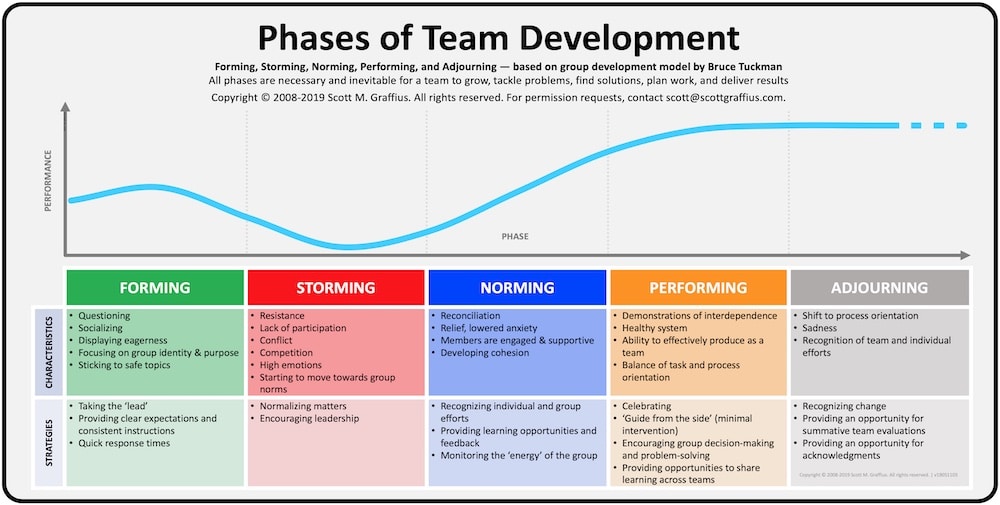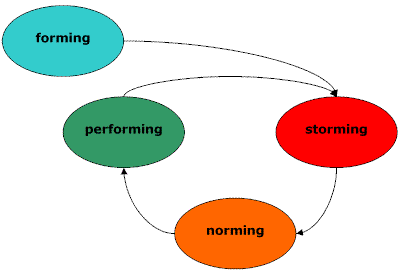Bruce Tuckman published his “Forming Storming Norming Performing” model in 1965. He added a fifth stage, Adjourning, in 1977. The Stages of Team Development Theory is an elegant and helpful explanation of team development and behaviour. Similarities can be seen with other models, such as Tannenbaum and Schmidt Continuum and especially with Hersey and Blanchard’s Situational Leadership model, developed about the same time.
The model is relevant in any Organisational Design effort.
Description
Tuckman’s model explains that as the team develops maturity and ability, relationships establish, and the leader changes leadership style. Beginning with a directing style, moving through coaching, then participating, finishing delegating and almost detached. At this point, the team may produce a successor leader and the previous leader can move on to develop a new team.
The original article identified four Stages of Team Development:
- Forming: The team is assembled and the task is allocated. Team members tend to behave independently and although goodwill may exist they do not know each other well enough to unconditionally trust one another.
- Storming: The team starts to address the task suggesting ideas. Different ideas may compete for ascendancy and if badly managed this phase can be very destructive for the team. Relationships between team members will be made or broken in this phase and some may never recover. In extreme cases, the team can become stuck and cease to be effective.
- Norming: In the ideal situation, teams begin to trust themselves during this phase as they accept the vital contribution of each member to the team. Team leaders can take a step back from the team at this stage as individual members take greater responsibility.
- Performing: Not all teams make it to the Performing phase, which is essentially an era of high performance. Performing teams are identified by high levels of independence, motivation, knowledge and competence.
To which later on another one was added
- Adjourning: This is the final phase added by Tuckman to cover the end of the project and the break up of the team.

Using Tuckman’s Model
As a team leader, your aim is to help your people perform well, as quickly as possible. To do this, you’ll need to make sure you are able to understand at which stage your team is and adapt your leadership style accordingly.
- Identify the stage of team development that your team is at.
- Now consider what you need to do to move towards the performing stage. Figure 1, helps understand the characteristics of each stage in details and lists the best strategies to succeed.
- Schedule regular reviews of where your team is, and adjust your behaviour and leadership approach appropriately.
- Be transparent about the stages and the usage of this tool: it will also help team members assess where they are in the journey.
| Stage | Activities | Skills Involved |
|---|---|---|
| 1. Forming | Select the Team Members and Direct the Team. Organize Workshops and establish the team’s purpose. Establish Goals and ways of measurement. | Curiosity Listening |
| 2. Storming | – Establish Process and Structures. – Use Transparency and Authenticity to cement the culture – Resolve conflict as they occurr Continue to be positive. | Authenticity Resilience |
| 3. Norming | – Step back, and help the team take responsibility – Review Purpose – This is a good moment for Team Building | Decision Making Be Deliberately Developmental Systems Thinking |
| 4. Performing | Ensure Delegation is consistently used | Learning Agility |
| 5. Adjourning | Celebrate the achievements Point out the learnings |
Resources
Below the original article. Tuckman, B. W. (1965). Developmental sequence in small groups. Psychological Bulletin, 63(6), 384–399.
c763010e6eb856250b939e4eec438e14ef8fThe image used in this post is available as a large format poster on Scott M. Graffius website.
Conclusion

Despite being dated, from experience I still find Tuckman’s Model to be very solid and relevant, and useful for any Manager, Human Resource Professional and Facilitator. One of the biggest critiques to the model is that it sometimes is too simplified when presented in a linear way.
Figure 2 presents an alternative way of representing the model, which specifically adapts to Aile teams for example.
And you? What do you think of this model? Write your comments below.

Cover Photo by Pascal Swier on Unsplash

[…] of emotions in a Change process. It is not a tool that solves issues, but instead gets the change team and the managers prepared on how employees might react. It also makes evident the need to […]